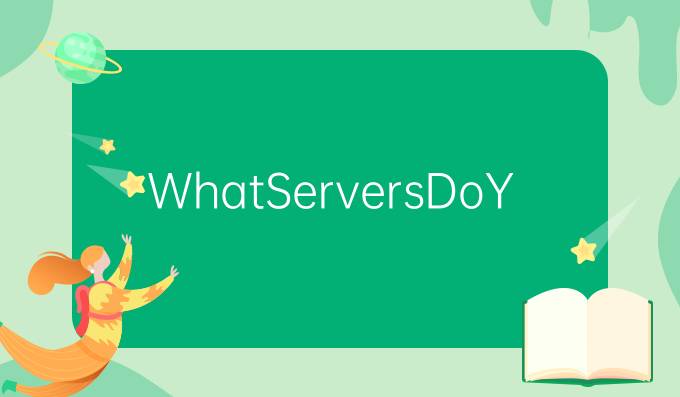
4007-702-802
Follow us on:



本文来源:ManLang 发布时间:2024-03-25 分享:

Abstra: Building a video streaming website requires careful consideration of the servers that will be used to handle the traffic and deliver high-quality content to users. This article explores the different types of servers needed for such a website and discusses their roles and funionalities.
Front-end servers play a crucial role in handling user requests and serving the initial webpage to users. These servers are responsible for interaing with the client-side applications, managing user sessions, and handling the initial data transfer. They are often equipped with load balancers to distribute the incoming requests across multiple back-end servers.

These servers also handle the encryption and decryption of data, ensuring secure communication between the website and the users. Additionally, front-end servers employ caching mechanisms to optimize content delivery, reducing latency and improving the streaming experience for users.
Furthermore, front-end servers are responsible for dynamically adapting the video playback quality based on the user's internet conneion, device capabilities, and other faors. This ensures smooth streaming and avoids buffering issues.
A CDN is an indispensable part of a video streaming website. It comprises a distributed network of servers strategically placed in different geographical locations. The primary purpose of a CDN is to cache and deliver content to users from the nearest server, reducing latency and improving data transfer speeds.
CDNs work closely with front-end servers to store and serve static content, such as images, CSS files, and JavaScript libraries. By offloading this content delivery to the CDN, front-end servers can focus on handling user requests for dynamic content, such as video streams.
CDNs also help mitigate the impa of traffic spikes by distributing the load across multiple servers, ensuring optimal performance even during peak usage hours. Additionally, they offer features like DDoS proteion and SSL termination, enhancing the security of the video streaming website.
Media servers are responsible for storing and delivering the video content to users. They manage the storage and retrieval of multimedia files, ensuring efficient delivery and playback. These servers are equipped with specialized software and hardware specifically designed to handle video streaming.
Media servers use adaptive streaming techniques, such as HTTP Live Streaming (HLS) or Dynamic Adaptive Streaming over HTTP (DASH), to deliver video content in various quality levels. This allows users to seamlessly switch between different resolutions based on their network conditions.
Furthermore, media servers support features like video transcoding and content encryption. Video transcoding involves converting the video file into different formats and bitrates to cater to different devices and network capabilities. Content encryption ensures that the video content remains secure and proteed from unauthorized access.
Database servers play a crucial role in managing user data, video metadata, and other information associated with the video streaming website. These servers store and retrieve data efficiently, providing fast access to the required information.
Database servers handle tasks like user authentication, user profile management, video metadata storage, and content cataloging. They ensure the reliability and consistency of data, allowing users to seamlessly navigate through the website and access their personalized content recommendations.
Furthermore, database servers are responsible for generating analytical data and colleing user metrics. This information helps in understanding user behavior, improving content recommendations, and optimizing the overall user experience of the video streaming website.
Summary: Building a video streaming website requires a combination of different servers to handle front-end interaions, content delivery, media storage, and database management. Front-end servers handle user requests, caching, and adaptive streaming. CDNs optimize content delivery and provide additional security features. Media servers manage the storage, delivery, and transcoding of video content. Database servers handle user data, metadata, and analytics. By utilizing a well-designed server infrastruure, a video streaming website can provide seamless and high-quality streaming experiences to users.
本文标签: WhatServers
猜您感兴趣的内容
Mastering Keyword Optimization and SEO: Elevate Your Online Presence and Drive Targeted Traffic
2025-02-12Top Brands Excelling in Content Marketing: Strategies and Success Stories
2024-10-19Enhancing SEM Account Performance: Strategies for Optimal Optimization
2024-04-25Outsourcing Web Design Services: Finding the Right Website Development Company
2024-05-16Global Digital Visibility Boost: Unleashing the Power of SEO for International Trade Promotion
2024-03-10Maximizing Online Performance: The Ultimate Guide to Outsourcing Website Optimization for Enhanced U
2025-02-23Unlocking Consumer Engagement: Innovative Examples of Effeive Content Marketing Strategies
2024-10-24Maximizing Online Visibility: Advanced Strategies for Effeive SEM and SEO Integration
2025-02-14您也许还感兴趣的内容
Unlocking Business Growth: Innovative B2B Content Marketing Strategies for the Modern Enterprise
2025-01-19Exploring the Diverse Categories of Content Marketing: A Comprehensive Guide to Strategies and Techn
2025-04-06Enhancing Brand Reach: Innovating Content Marketing Strategies
2024-03-21The Power of Word-of-Mouth: Exceptional Examples of Buzz Marketing
2024-01-28Unlocking Success: Expert SEM Account Management Services for Optimal Performance and Growth
2025-02-09Unlocking SEO Success: Advanced Techniques to Boost Your Websites Visibility and Drive Organic Traff
2025-04-08Unlocking the Power of SEO Resources: Essential Tools, Strategies, and Insights for Boosting Your We
2025-03-26Unlocking the Power of Content Marketing: Four Strategic Approaches to Engage and Convert Audiences
2025-01-15